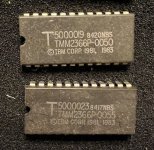pkhoury
Experienced Member
I did read that list, but it was a little confusing, only because I personally would group it by problems encountered. Either way, hopefully my replacement EEPROMs will do the trick, as well as getting a copy of Ruud's burned onto one, so I can further diagnose. On the plus side, at least everything else seems to check out okay, aside from the first 16KB of RAM and those two offending ROMs.I cannot answer that, but maybe someone else can. I have not seen any kind of 'ROM failure statistics by make-model' list.
Even if the scope is reduced to ROM's fitted to the 5150 motherboard, the list at [here] suggests a low failure rate. I doubt that a statistically significant sample size of U33/BASIC ROM failures exists.
On a segue - is my computer the earliest serial anyone's seen by far, or do earlier examples exist?


